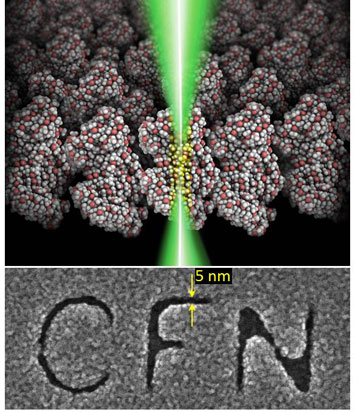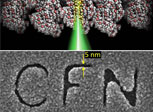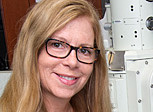Research Highlight: Drawing at the One-Nanometer Length Scale
innovation at CFN
August 1, 2017
What is the scientific achievement?
CFN scientists adapted a state-of-the-art scanning transmission electron microscope (STEM) for lithography in order to achieve unprecedented one-nanometer resolution—i.e., at the single-molecule level. This resolution is a significant improvement over the previous resolution limit of electron-beam lithography (EBL), a widely used nanofabrication technique.
Why does this achievement matter?
 enlarge
enlarge
Top: Illustration of a focused electron beam (green) shining through a polymeric film (round particles are atoms of the film). The glowing area indicates the feature to be fabricated at the molecular length scale. Bottom: An arbitrary design printed at single-digit nanometer dimensions.
But prior to this achievement, patterning materials at a single nanometer—the scale at which properties are predicted to change for certain materials, such as silicon—was not possible in a controllable and efficient way. Commercial EBL instruments typically pattern materials at sizes between 10 and 20 nm, and techniques that can produce higher-resolution patterns require special conditions that either limit their practical utility or dramatically slow down the patterning process.
The CFN scientists' new STEM-based lithography system opens up many exciting materials engineering possibilities for tailoring properties closer to the atomic scale. The CFN we will soon be offering this first-of-a-kind nanoscience tool to users from around the world.
What are the details?
CFN Capabilities: The Nanofabrication and Electron Microscopy Facilities were used for nanostructure fabrication, processing, and imaging.
Performing EBL with one of CFN's aberration-corrected STEMs outfitted with a pattern generator, the CFN scientists patterned thin films of the polymer poly(methyl methacrylate), or PMMA, with individual features as small as 1 nm, and with a spacing between features of 11 nm, yielding an areal density of nearly one trillion features per square centimeter. Their measurements with this instrument show a nearly 200 percent reduction in feature size (from 5 to 1.7 nm) and 100 percent increase in areal pattern density (from 0.4 to 0.8 trillion dots per square centimeter, or from 16 to 11 nm spacing between features) over previous scientific reports.
The patterned PMMA films can be used as stencils for transferring the drawn single-digit nanometer feature into any other material. In this work, the scientists created structures smaller than 5 nm in both metallic (gold palladium) and semiconducting (zinc oxide) materials. Their fabricated gold palladium alloy features were as small as six atoms wide.
Publication Reference
"Aberration-Corrected Electron Beam Lithography at the One Nanometer Length Scale"
V.R. Manfrinato, A. Stein, L. Zhang, C.-Y. Nam, K.G. Yager, E.A. Stach, and C.T. Black
Center for Functional Nanomaterials, Brookhaven National Laboratory, Upton, New York, 11973, United States
Nano Letters 17 (2017)
Acknowledgement of Support
This research used resources of the Center for Functional Nanomaterials, which is a U.S. DOE Office of Science Facility, at Brookhaven National Laboratory under Contract No. DE-SC0012704. We would like to acknowledge Gwen Wright, Ming Lu, and Dong Su for technical assistance. We would like to acknowledge Dr. Richard G. Hobbs from Trinity College Dublin, Prof. Huigao Duan from Hunan University, and Prof. Karl Berggren from Massachusetts Institute of Technology for scientific discussions.
2017-12397 | INT/EXT | Newsroom












